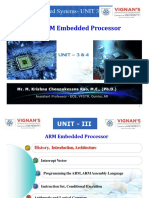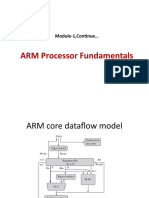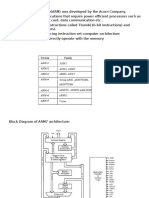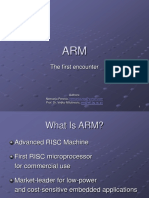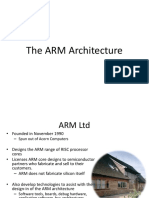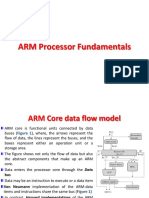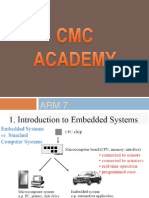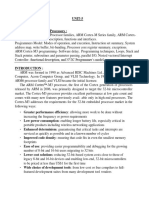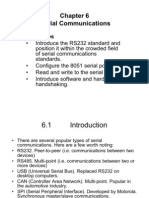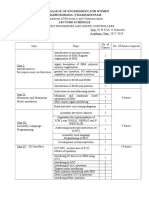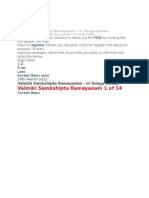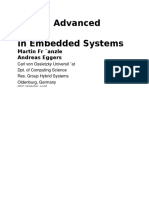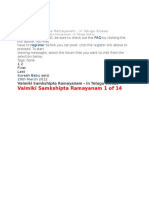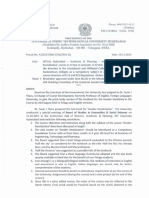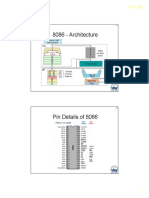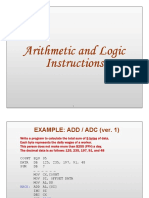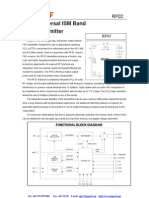Chapter 2
ARM Processor Fundamentals
(Note: MAC = multiply-accumulate unit)
- A 32-bit processor implemented either by
Von Neumann architecture ( shown above)
or
Harvard architecture with 2 types of instruction sets—
load and store instructions
- Instructions have 2 source registers (Rn and Rm) and one destination
register (Rd)
- Rm can be preprocessed in the barrel shifter before it enters the ALU
1
�2.1 Register
- Up to 18 active register:
16 data registers (r0~r15) : for holding either data or address
2 processor status registers
- r13 : stack pointer (sp)
- r14 : link register (lr)
- r15 : program counter (pc)
- r0~r13 are orthogonal (equally well application)
- cpsr : current program status register
- spsr : saved program status register
2
�2.2 Current Program Status Register
Divided into 4 fields (each with 8-bit wide):
- Flags : holding instruction conditions
- Status : reserved
- Extension : reserved
- Control : indicate the processor mode
3
�2.2.1 Processor Modes
- The processor mode determines which registers are active and
the access rights to the cpsr register itself.
- 7 processor modes:
Processor mode Abbrev. Description Notes
Noraml program exection
User usr
mode
Run privileged OS tasks
System sys P
A protected mode for the OS
Supervisor svc p, e
Implements virtual memory
Abort abt p, e
and/or memory protection
Supports software emulation
Undefined und p, e
of hardware coprocessors
Used for general-purpose
Interrupt irq p, e
interrupt handling
Supports a high-speed data
Fast interrupt fiq p, e
transfer or channel process
[note] Privileged modes : p Execption modes : e
- Each process mode is either privileged or nonprivileged
A privileged mode allows full read-write access to the cpsr
A nonprivileged mode only allows to read access to the
control filed in the cpsr but still allows read-write access to
the condition flags.
4
�2.2.2 Banked Registers
- 37 registers in the register file.
- 20 registers, called banked registers (identifed by the shading in the
diagram), are hidden from a program at different times.
- All processor modes except system mode have a set of associate banked
registers that are a subset of the main 16 registers.
- A banked register maps one-to-one onto a user mode register
- The processor mode can be changed by a program that writes directly to
the cpsr, if it has the privilege.
- The following exceptions and interrupts cause a mode change:
+ Reset
+ Interrupt request
+ Fast interrupt request
+ Software interrupt
+ Data abort,
+ Prefetch abort
+ Undefined instruction.
5
�2.2.2 Banked Registers (cont.)
- The cprs is not coped into spsr when a mode change is
forced due to a program writing directly to the cpsr.
- The saving of the cspr only occurs when an exception or
interrupt is raised.
6
�2.2.3 State and Instruction Sets
- There are 3 instruction sets :
ARM – 32-bit instructions
Thumb – 16-bit instructions
Jeazelle – 8-bit instructions
- No intermingle sequence of different instruction set is
allowed.
- The hardware portion of Jazelle only supports a subset of the
Java byecodes; the rest are emulated in software.
2.2.4 Interrupt masks
- Two interruput marks—I and F—are used to stop specific
interrupt requests from interrupting the processor.
- The mask bits, 7 and 6 (or I and F), are used to control the
masking of IRQ and FIQ, respectively.
7
�2.2.5 Condition Flags
- The hardware only sets the flags.
- To clear the flag you need to write to the cpsr.
- Bit 5 is used to set for thumb-enable.
- Bit 24 is uese to set for Jazelle-enable.
8
�2.2.6 Condition Execution
- Most instructions have a condition attribute that determines if
the core will execute it based on the setting of the condition
flag.
- The condition attribute is postfixed in the instruction
mnemonic, which is coded into the instruction.
9
�2.3 Pipeline
- to speed up instruction execution
- ARM9 : 1.1 Dhrystone MIPS per Mhz—an increasing in
instruction throughput by around 13% compared with an
ARM7.
- ARM10 : 1.3 Dhrystone MIPS per Mhz—an increasing in
instruction throughput by around 34% compared with an
ARM7.
-
10
�- 2.3.1 Pipeline Executing Characteristics
- In ARM state, the pc always points to the address of the
instruction plus 8 bytes.
- In Thumb state, the pc is the instruction address plus 4 bytes
- The execution of a branch instruction or branching by the
direct modification of the pc causes the ARM core to flush its
pipeline
.
- ARM10 uses branch prediction which reduces the effect of a
pipeline flush.
- An instruction in the execute stage will complete even though
an interrupt has been raised. Other instructions in the pipeline
will be abounded.
11
� 2.4 Exceptions, Interrupts, and the Vector Table
- When an exception or interrupt occurs, the processor sets the
pc to a specific memory address.
- The interrupt address is within a special address called vector
table
- The entries in the vector table are instructions that branch to
specific routines designed to handles a particular exception or
interrupt.
- The memory map address 0x0000000 is reserved for the vector
table, a set of 32-bit words.
- On some processes the vector table can be optionally located at
a higher address in memory—starting at the offset 0xffff0000.
12
�2.5 Core Extensions
- To improve performance, manage resources, and provide
extra functionality.
- - Three hardware extension: cache and tightly couple menory,
memory management, and coprocessor interface.
2.5.1 Cache and Tightly Couple Memory
- Two types of cache:
+ cache for the combination of data and instruction which is
attached to the von Neumann-style core.
+ cache for separated data and instruction which is attached
to the Harvard-style core.
13
�2.5.1 Cache and Tightly Couple Memory (cont.)
- The tightly coupled memory (TCM), a type of fast SRAM, is
located close to the core for the real-time system.
- TCMs appear as memory in the address map and can be
accessed as fast memory.
- A combination of caches and TCMs is shown below.
14
� 2.5.2 Memory Management
- Generally, embedded system use multiple memory
devices—ROM, SRAM, FlahROM, DRAM
- It’s necessary to have a method to help organize these devices
and protect the system from applications trying to make
inappropriate accesses to hardware.
- ARM cores have 3 different types of memory management
hardware:
+ No extensions – nonprotected memory for small, simple
embedded systems.
+ Memory protection unit (MPU) – using a limited number of
memory region which are controlled with a set of special
coprocessor registers, and each region is defined with
specific access permission.
+ Memory management unit (MMU) – using a set of
translation table to provide fine-grained control over
memory, which are stored in main memory and provide a
virtual-to-physical address memory map as well as access
permission.
15
�2.6 Architecture Revisions
Every ARM processor implementation executes a specific
instruction set architecture—ISA.
2.6.1 Nomenclature
- JTAG : IEEE1149.1 Standard Test Access Port
- EmbeddedICE macrocell : the debug hardware built into the
processor that allows breakpoints and watchpoints to be set.
(ICE : in-circuit emulator)
- Synthesizible : meaning that the processor core is supplied as
source code that can be compiled into a form easily used by
EDA (electronic design automation) tools.
16
�2.6.2 Architecture Evolution
17
�2.7 ARM Processor Families
-end-
18

